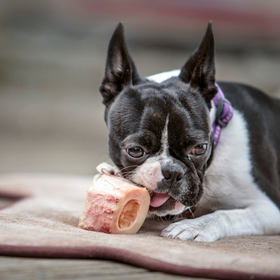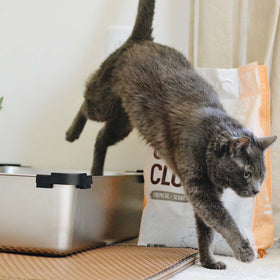
Help with Seasonal Allergies
Taking action before symptoms kick in can help ease the suffering associated with seasonal allergies. For some dogs, allergies manifest as itchy, flaky skin, and the degree of scratching can range from minor to maddening. For others, there can be added complications, including skin inflammation or redness, and even hot spots or yeast.
Allergy symptoms are either an overreaction or under-reaction of the immune system, so supporting and balancing that system is key. And if your dog is hot, red, or suffers from hot spots, you’ll also need to address that heat from within.
Diet
It’s our belief that you’ll never cure allergies without feeding a fresh, whole food diet, or at least one that is mostly whole food based.
Why?
Kibble is a highly processed starch; it’s a biologically inappropriate diet for a dog (or a human for that matter). Like us, dogs thrive on real food. Skin needs fresh, unadulterated fats and proteins. The gut loves fibre. The body craves moisture. These are all key elements when it comes to supporting your allergic dog.
So, if not kibble, then what?
Balanced raw diets
When feeding raw food, it’s important to make sure proteins are rotated. Since every protein has its own unique nutrient profile, rotation ensures your dog is getting all the different nutrients and minerals that they need. If for any reason you ’re unable to rotate, such as if your dog has an allergy or intolerance, you should be adding additional supplements.
As well as what’s in it, where your food comes from is also important. Make sure your raw food is coming from a manufacturer that provides a guaranteed analysis and makes its products in a human grade facility.
Balanced gently cooked diets
Making sure your dog gets a fresh cooked diet doesn’t need to be time-consuming and difficult. There are many commercial options available.
If your dog isn’t yeasty and only has seasonal allergies, they’ll likely do well on a diet that contains a moderate amount of carbs. Low carb options are also available, but they cost a bit more.
If you want to make your own food at home, it’s vital that you work with a qualified advisor to ensure the meals are properly balanced. Homemade diets are often lacking in key nutrients, such as zinc, that play a huge role in skin health.
Dehydrated or freeze-dried raw
Similar to fresh and frozen raw, it’s important to rotate proteins and ensure the product comes from a reputable company. And whenever possible, provide some moisture-rich additions, such as fresh meats and fish, kefir, bone broth, or pureed vegetables and berries.
High quality kibble with fresh additions
If you’re feeding a mix of kibble with fresh foods, 30–50% of calories should come from fresh food. Avoid adding starch, like rice or potatoes. Kibble has more than enough starch already (that’s how it’s held together).
For fresh food proteins, you can use poultry, red meat, fish, and eggs. For fresh produce, use greens, squash, and berries.
If you’re only replacing 30% of the meal with fresh food, you don’t need to provide nutritional balance, but you should still provide your dog with variety.
If you’re replacing more than 30% of the meal with fresh food, you should use a balanced commercial product or create your own balanced meals with the help of a professional.
Supplements
Can supplements actually help? Yes!
Balance the immune system
Since allergy symptoms are the result of an immune system that’s reacting inappropriately, we need to correct it. One of our favourite supplements is an herbal product called Cessorex. It helps balance the immune system, and you’ll be able to watch it happen: the itching calming down and the skin beginning to heal.
Another favourite is bovine colostrum (mother’s milk), which contains immune-boosting compounds that can help reduce inflammation, neutralize allergens, and promote a healthy gut microbiome.
Support the gut
Think of the gut microbiome as the command centre for overall wellness. We need to protect the bugs on deck so they can steer the ship correctly!
First: Feed those bugs well! Make sure they’re getting lots of fibre, because they need it to thrive.
Second: Protect the bugs! They really dislike drugs, such as tick medications and antibiotics. They’re also sensitive to chronic stress.
Adding probiotics to your dog’s diet also helps support gut and skin health. This is especially important if there’s yeast. Some of our favourites include Love Bugs and Protect.
Feed the skin
A high-quality omega fatty acid is key. It feeds the skin (among other important things) and reduces inflammation. There are a lot of omega oils on the market, and it ’s important to choose one that works. In fact, it ’s so important, we even wrote a blog post about choosing the most effective omega oil.
Desensitize
Leading up to allergy season and throughout, add unpasteurized, local, raw honey or bee pollen to your dog’s food. Local is key here: it must come from an area close to where you live. This will help prepare your dog’s system for the pollen that affects them… sort of like an inoculation. Raw honey should not be given to dogs under 12 months.
Natural antihistamines
If you want to help relieve symptoms, find quercetin (aka “nature’s Benadryl”).
We love Skin & Coat and Harmony for this. Not only do they contain this natural antihistamine, they also provide zinc and digestive enzymes that help metabolize it as well as the food.
Topical treatments
Yeast growing on the skin’s surface must be eliminated, otherwise it will continue to feed itself. Sometimes you need pharmaceutical strength cleansers, but other times, there are natural shampoos, like 4-Legger’s Calming and Cooling shampoos, that can do wonders when it comes to fighting bacteria.
Once your pup is clean, apply a natural, antibacterial rinse. You can purchase one or make one. 4-Legger’s Restore is our favourite. If you want to try and speed up healing and relieve discomfort, natural hot spot sprays can also help.
When you’re dealing with an environmental allergy, wipe your dog down with a clean, damp cloth after each outing (and don’t forget their paws!). Air filters in the home also help a great deal.
Allergy support
If you're still looking to explore some products, you can view our complete Allergy Support Collection on our website.
And of course, if you need more personalized help, drop us an email.









